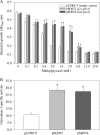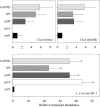Concomitant Loss of the Glyoxalase System and Glycolysis Makes the Uncultured Pathogen "Candidatus Liberibacter asiaticus" an Energy Scavenger
- PMID: 28939611
- PMCID: PMC5691416
- DOI: 10.1128/AEM.01670-17
Concomitant Loss of the Glyoxalase System and Glycolysis Makes the Uncultured Pathogen "Candidatus Liberibacter asiaticus" an Energy Scavenger
Abstract
Methylglyoxal (MG) is a cytotoxic, nonenzymatic by-product of glycolysis that readily glycates proteins and DNA, resulting in carbonyl stress. Glyoxalase I and II (GloA and GloB) sequentially convert MG into d-lactic acid using glutathione (GSH) as a cofactor. The glyoxalase system is essential for the mitigation of MG-induced carbonyl stress, preventing subsequent cell death, and recycling GSH for maintenance of cellular redox poise. All pathogenic liberibacters identified to date are uncultured, including "Candidatus Liberibacter asiaticus," a psyllid endosymbiont and causal agent of the severely damaging citrus disease "huanglongbing." In silico analysis revealed the absence of gloA in "Ca Liberibacter asiaticus" and all other pathogenic liberibacters. Both gloA and gloB are present in Liberibacter crescens, the only liberibacter that has been cultured. L. crescens GloA was functional in a heterologous host. Marker interruption of gloA in L. crescens appeared to be lethal. Key glycolytic enzymes were either missing or significantly downregulated in "Ca Liberibacter asiaticus" compared to (cultured) L. crescens Marker interruption of sut, a sucrose transporter gene in L. crescens, decreased its ability to take up exogenously supplied sucrose in culture. "Ca Liberibacter asiaticus" lacks a homologous sugar transporter but has a functional ATP/ADP translocase, enabling it to thrive both in psyllids and in the sugar-rich citrus phloem by (i) avoiding sucrose uptake, (ii) avoiding MG generation via glycolysis, and (iii) directly importing ATP from the host cell. MG detoxification enzymes appear to be predictive of "Candidatus" status for many uncultured pathogenic and environmental bacteria.IMPORTANCE Discovered more than 100 years ago, the glyoxalase system is thought to be present across all domains of life and fundamental to cellular growth and viability. The glyoxalase system protects against carbonyl stress caused by methylglyoxal (MG), a highly reactive, mutagenic and cytotoxic compound that is nonenzymatically formed as a by-product of glycolysis. The uncultured alphaproteobacterium "Ca Liberibacter asiaticus" is a well-adapted endosymbiont of the Asian citrus psyllid, which transmits the severely damaging citrus disease "huanglongbing." "Ca Liberibacter asiaticus" lacks a functional glyoxalase pathway. We report here that the bacterium is able to thrive both in psyllids and in the sugar-rich citrus phloem by (i) avoiding sucrose uptake, (ii) avoiding (significant) MG generation via glycolysis, and (iii) directly importing ATP from the host cell. We hypothesize that failure to culture "Ca Liberibacter asiaticus" is at least partly due to its dependence on host cells for both ATP and MG detoxification.
Keywords: ATP/ADP translocase; carbonyl stress; citrus greening; culturability; glycolysis; glyoxalase; huanglongbing; liberibacter; methylglyoxal; sugar transporter.
Copyright © 2017 American Society for Microbiology.
Figures




Similar articles
-
Growth Dynamics and Survival of Liberibacter crescens BT-1, an Important Model Organism for the Citrus Huanglongbing Pathogen "Candidatus Liberibacter asiaticus".Appl Environ Microbiol. 2019 Oct 16;85(21):e01656-19. doi: 10.1128/AEM.01656-19. Print 2019 Nov 1. Appl Environ Microbiol. 2019. PMID: 31420343 Free PMC article.
-
A Small Wolbachia Protein Directly Represses Phage Lytic Cycle Genes in "Candidatus Liberibacter asiaticus" within Psyllids.mSphere. 2017 Jun 7;2(3):e00171-17. doi: 10.1128/mSphereDirect.00171-17. eCollection 2017 May-Jun. mSphere. 2017. PMID: 28608866 Free PMC article.
-
'Candidatus Liberibacter asiaticus'-Encoded BCP Peroxiredoxin Suppresses Lipopolysaccharide-Mediated Defense Signaling and Nitrosative Stress In Planta.Mol Plant Microbe Interact. 2022 Mar;35(3):257-273. doi: 10.1094/MPMI-09-21-0230-R. Epub 2022 Mar 10. Mol Plant Microbe Interact. 2022. PMID: 34931906
-
Progress and Obstacles in Culturing 'Candidatus Liberibacter asiaticus', the Bacterium Associated with Huanglongbing.Phytopathology. 2019 Jul;109(7):1092-1101. doi: 10.1094/PHYTO-02-19-0051-RVW. Epub 2019 Jun 3. Phytopathology. 2019. PMID: 30998129 Review.
-
Tale of the Huanglongbing Disease Pyramid in the Context of the Citrus Microbiome.Phytopathology. 2017 Apr;107(4):380-387. doi: 10.1094/PHYTO-12-16-0426-RVW. Epub 2017 Feb 6. Phytopathology. 2017. PMID: 28095208 Review.
Cited by
-
Development on Citrus medica infected with 'Candidatus Liberibacter asiaticus' has sex-specific and -nonspecific impacts on adult Diaphorina citri and its endosymbionts.PLoS One. 2020 Oct 6;15(10):e0239771. doi: 10.1371/journal.pone.0239771. eCollection 2020. PLoS One. 2020. PMID: 33022020 Free PMC article.
-
Controlled replication of 'Candidatus Liberibacter asiaticus' DNA in citrus leaf discs.Microb Biotechnol. 2020 May;13(3):747-759. doi: 10.1111/1751-7915.13531. Epub 2020 Jan 20. Microb Biotechnol. 2020. PMID: 31958876 Free PMC article.
-
Comparative Proteomic Analysis of Sweet Orange Petiole Provides Insights Into the Development of Huanglongbing Symptoms.Front Plant Sci. 2021 Apr 19;12:656997. doi: 10.3389/fpls.2021.656997. eCollection 2021. Front Plant Sci. 2021. PMID: 33953735 Free PMC article.
-
A high-throughput system to identify inhibitors of Candidatus Liberibacter asiaticus transcription regulators.Proc Natl Acad Sci U S A. 2019 Sep 3;116(36):18009-18014. doi: 10.1073/pnas.1905149116. Epub 2019 Aug 19. Proc Natl Acad Sci U S A. 2019. PMID: 31427509 Free PMC article.
-
An in vitro protocol for rapidly assessing the effects of antimicrobial compounds on the unculturable bacterial plant pathogen, Candidatus Liberibacter asiaticus.Plant Methods. 2019 Jul 31;15:85. doi: 10.1186/s13007-019-0465-1. eCollection 2019. Plant Methods. 2019. PMID: 31384290 Free PMC article.
References
-
- Ammar E-D, Shatters RG Jr, Lynch C, Hall DG. 2011. Detection and relative titer of Candidatus Liberibacter asiaticus in the salivary glands and alimentary canal of Diaphorina citri (Hemiptera: Psyllidae) vector of citrus huanglongbing disease. Ann Entomol Soc Am 104:526–533. doi:10.1603/AN10134. - DOI
Publication types
MeSH terms
Substances
LinkOut - more resources
Full Text Sources
Other Literature Sources

